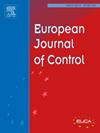Pitot tube measure-aided air velocity and attitude estimation in GNSS denied environment
IF 2.5
3区 计算机科学
Q2 AUTOMATION & CONTROL SYSTEMS
引用次数: 0
Abstract
This paper addresses the problem of estimating air velocity and gravity direction for small autonomous fixed-wing drones in GNSS1-denied environments. The proposed solution uses a minimal sensor suite, relying on Pitot tube measurements and Inertial Measurement Unit (IMU) signals, including only gyrometers and accelerometers. The approach combines the Riccati observer and Equivariant Filter designs, using an over-parametrization technique to design an observer on and subsequently re-project to to estimate the gravity direction. The system’s observability is analyzed, and local exponential stability of the origin of the observer error is demonstrated as long as the aircraft attitude is persistently exciting. The observer was evaluated using simulated and real flight data to showcase the estimator’s performance.
全球导航卫星系统拒绝环境下的皮托管测量辅助气流速度和姿态估计
本文探讨了小型自主固定翼无人机在全球导航卫星系统(GNSS)1失效环境中估算气流速度和重力方向的问题。提出的解决方案使用了最小传感器套件,依赖于皮托管测量和惯性测量单元(IMU)信号,仅包括陀螺仪和加速度计。该方法结合了里卡提观测器和等变滤波器设计,使用过参数化技术在 SO(3)×R3 上设计一个观测器,然后重新投影到 S2×R3 以估计重力方向。分析了系统的可观测性,并证明了只要飞机姿态持续令人兴奋,观测器误差起源的局部指数稳定性。利用模拟和实际飞行数据对观测器进行了评估,以展示估计器的性能。
本文章由计算机程序翻译,如有差异,请以英文原文为准。
求助全文
约1分钟内获得全文
求助全文
来源期刊

European Journal of Control
工程技术-自动化与控制系统
CiteScore
5.80
自引率
5.90%
发文量
131
审稿时长
1 months
期刊介绍:
The European Control Association (EUCA) has among its objectives to promote the development of the discipline. Apart from the European Control Conferences, the European Journal of Control is the Association''s main channel for the dissemination of important contributions in the field.
The aim of the Journal is to publish high quality papers on the theory and practice of control and systems engineering.
The scope of the Journal will be wide and cover all aspects of the discipline including methodologies, techniques and applications.
Research in control and systems engineering is necessary to develop new concepts and tools which enhance our understanding and improve our ability to design and implement high performance control systems. Submitted papers should stress the practical motivations and relevance of their results.
The design and implementation of a successful control system requires the use of a range of techniques:
Modelling
Robustness Analysis
Identification
Optimization
Control Law Design
Numerical analysis
Fault Detection, and so on.
 求助内容:
求助内容: 应助结果提醒方式:
应助结果提醒方式:


